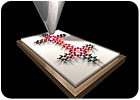
Innovation is one of the hottest buzzwords in the business world today. It can be applied many different ways in many different industries. But, no matter which way it's harnessed, innovation plays a key role in the product design and development process.
Innovation is one of the hottest buzzwords in the business world today. Many companies love to throw the word around and talk about how they are “innovative.”
Even the U.S. Department of Commerce (Washington, DC) has gotten in on the innovation act. It recently announced that it’s taking steps to explain and quantify what it calls “one of the largest and most elusive drivers of the economy-innovation.”
According to Commerce Secretary Carlos Gutierrez, “innovation has proven an essential driver of growth for the U.S. economy. The United States today is more than 75 percent wealthier in terms of real GDP per capita than it was 30 years ago, which is largely attributable to productivity gains driven, in large part, by innovation.”
Innovation can be applied many different ways in many different industries. But, no matter which way it’s harnessed, innovation plays a key role in the product design and development process.
“Today, there’s a lot more focus on operational efficiency to get cost out of the equation,” notes Michael Burkett, vice president of AMR Research Inc. (Boston). “It’s great to suck cost out, but to maintain a sustainable business, you must bring new products to market. With innovation, you get margin. That’s why you need to be out in front of your competitors.”
Innovation is basically the process of developing a solution that addresses unmet customer needs. Specifically, it’s the process of creating value via improvements to products, the way they are manufactured and assembled, and the way they are delivered.
The Product Development and Management Association (Mount Laurel, NJ) defines innovation as, “A new idea, method or device. The act of creating a new product or process. The act includes the work required to bring an idea or concept into final form.”
Today, most manufacturers rate innovation as a top strategic priority. However, many senior executives claim that they are dissatisfied with the return they get from their innovation dollars.
“A key reason [for that dissatisfaction] is that most companies confuse ideas or inventions with innovation,” says Jim Andrew, a senior partner at the Boston Consulting Group (Boston). “True innovation must lead-directly or indirectly-to increased profits.
“Innovation is not synonymous with creativity or invention,” adds Andrew. “It’s a process that takes new knowledge and uses it to generate a payback. The term is often misused and abused.”
According to Andrew, the vast majority of money that manufacturers generate is not made in breakthroughs. “It comes from improving the products they already have,” he points out.
“The innovation problem has little to do with good ideas,” argues Andrew, who recently wrote a book on the topic. “There are lots of them. Most companies do not have an idea generation problem. In many cases, idea worship derails and dilutes companies’ focus on getting payback from innovation.
“Even at the best companies, up to a third of all innovation initiatives are wasting cash and human resources,” warns Andrew. “The challenge is to identify which projects need to be curtailed so ones with real potential can be focused on [so that new products can be] brought to market faster with a higher probability of success.”
“In the short run, every company needs to manage manufacturing, supply chain, human resources and other basic elements,” explains Rob Shelton, director of the product and service innovation practice at PRTM Management Consultants (Waltham, MA). “In the long run, the only reliable security for any company is the ability to innovate better and longer than competitors.”

Open innovation approaches help companies generate bold new product ideas, such as these personal mobility vehicles developed by engineers at Toyota Motor Corp.
Innovation Is Important
Innovation has been around for a long time. But, it’s been getting a lot more attention lately, because in today’s competitive climate, manufacturers must carefully manage new product introductions to accelerate time to market, reduce costs and exceed customer expectations.“Manufacturers are under more pressure to innovate today,” says Andrew. “Globalization has increased both the stress of innovation and the risk of not innovating.” New product ideas can come from anywhere, anytime, and they now come more rapidly than ever.
Barry Jaruzelski, vice president of Booz Allen Hamilton Inc. (New York) believes that today’s innovation craze is driven by insecurity created by globalization. “Innovation is popular because we can’t out-cost China and India,” he points out. “It’s a way to outsmart them and compete successfully against the cost lever.
“In today’s flattened world, innovation and product development can be used as a differentiator,” adds Jaruzelski. “Innovation is also popular because it’s a positive thing. It’s not about cutting jobs; it’s growth-oriented.”
Today, competitive advantages are more temporary than ever. Product cycles are much faster than in the past. Information flows globally and instantaneously; talent can be found and utilized globally. Low labor cost regions can undercut product costs, and the pace of technological change continues to accelerate.
“A1l these things make standing still slow death if a market is healthy,” warns Bob Becker, managing director of the Product Development Advantage Group LLC (Westford, MA). “Therefore, people are compelled to try to continuously innovate to reap the temporary competitive advantages where they can. A competence in doing this well may be one of the only sustainable advantages that exists.”
Smart companies are using innovation strategically to develop new products. “People have been consistently innovative throughout time,” adds Joe Sinfield, partner at Innosight LLC (Watertown, MA), a consulting firm. “However, the way in which we innovate has changed substantially. In the past, innovation was frequently relegated to serendipity and often focused on technology.
“Today, more and more people are realizing that successful innovation can be driven by building upon patterns of success from the past,” adds Sinfield. “In addition, manufacturers in every industry have begun to see their choice of business model as an even more powerful lever of innovation than technology, and one that can often be exploited more rapidly and at lower cost.”
Sinfield says many different forces are driving innovation today. “For some, the catalyst is cost pressure,” he explains. “For others, it is often a desire to step out of the monotonous cycles of undifferentiated product launches. For still others, innovation is sparked by a growth gap-that is, a desire to achieve profit and revenue targets that exceed that which can be reasonably expected from their current development pipeline. Regardless of the cause, innovation equals competitive differentiation.”
Successful Strategies
The product development process isn’t what it used to be. In recent years, some of the best new ideas, such as Apple’s iPod, have come from “manufacturers” that don’t even own or operate their own assembly lines. In fact, some companies have even outsourced the traditional design function.Today, manufacturers take many different approaches to creating innovation and developing it into profitable products. “Companies that are rated ‘highly innovative’ tend to be much more profitable than others,” says John Kao, an innovation consultant based in San Francisco. “They embrace innovation as a strategic tool.” However, Kao claims the United States lags behind other countries, such as Denmark and Finland, when it comes to innovation.
According to an annual study conducted by the Boston Consulting Group, the world’s most innovative manufacturers include Apple, Boeing, General Electric and Toyota. Toyota Motor Corp. (Nagoya, Japan) qualifies as being innovative thanks to cutting-edge ideas such as the Prius hybrid and the i-unit personal mobility vehicle. Ditto for the dudes at Apple Computer Inc. (Cupertino, CA) who thought up the iPod and all its wacky derivatives. Engineers at Boeing Co. (Chicago) who are developing the revolutionary new 787 Dreamliner also understand how to leverage innovation.
General Electric Co. (GE, Fairfield, CT) has invested billions of dollars in R&D projects that focus on growth areas such as composites manufacturing, nanotechnology, organic light-emitting diodes and solar energy. “We have always viewed technology as a means to delivering breakthrough products and solutions for our customers,” says Mark Little, senior vice president and director of GE Global Research. “We pride ourselves on pushing the limits of innovation to change the world.”
However, developing breakthrough products, revamping operational processes and coming up with new business models doesn’t happen overnight. “It requires organizations that continuously innovate rather than relying on gimmicks or incremental line extensions,” explains Boston Consulting’s Andrew.
Speed is an important factor, but it’s also the biggest barrier to successful innovation. “I often hear people say ‘it takes too long,’” notes Andrew. “But, if you try to take all of the risk out of innovation, you’ll only be innovative by accident.”
Many manufacturers also make the mistake of thinking that innovation is something that only high-tech companies do. “Some companies have forgotten how to grow,” claims Andrew.
“Companies now have better control of the execution of innovation and it is more predictable,” adds PRTM’s Shelton. They are combining the complementary benefits of technology innovation, including innovations in manufacturing and product features, and business model innovation, including improvements in the supply chain, partnerships and the value delivered to the customer.
“The result has been more business bang for the innovation buck,” explains Shelton. “The iPod was Apple’s technology innovation and iTunes was its business model innovation. Each was powerful; together they have been dynamite and given Apple more than 70 percent market share.”
According to Shelton, manufacturers have learned how to organize and use innovation resources better than ever before. Old approaches focused on using internal resources and developing innovation from the inside out.
New, open innovation approaches weave together internal and external resources into a value network that delivers bottom line results better, faster and cheaper than in the past. “Boeing and Toyota have demonstrated the value of open innovation, and of making partnering a core competency,” says Shelton.

Innovation provides a company the opportunity to grow better, faster and smarter than its competitors. This single-molecule logic switch recently developed by engineers at IBM Corp. could some day provide the building block for computers built from molecular components.
Listen to Your Customers
Customers play a key role in the innovation process. In fact, paying close attention to them can pay off in more ways than one. According to Booz Allen’s Jaruzelski, manufacturers that get direct customer insight have superior financial performance over the long term. In a recent study, he discovered that “companies that directly engaged their customer base had twice the return on assets and triple the growth in operating income of the other survey respondents.”Top-performing companies know how to tap into their customer base for insight before developing new products. “Innovation, no matter what position an organization holds in the value chain, is sparked by a deep understanding of end user needs,” says Innosight’s Sinfield. “No value chain is sustainable without some form of ‘pull’ at the end.”
The first step in the product development process should be developing deep customer and consumer insight. “With this knowledge in hand, an organization can then focus on applying a rigorous process to link customer insights to the design, manufacturing and commercialization elements of its product development process,” explains Sinfield. Unfortunately, he says manufacturers often make two critical mistakes when attempting to innovate.
“First, they frequently listen only to their best customers,” notes Sinfield. “As a result, they tend to pursue wish-list product enhancements and gradually alienate an ever increasing proportion of the market. Along the same line, particularly among companies that are somewhat removed from end consumer contact, some organizations rely on their direct customers to tell them what end users further down the value chain may want. This, too, leaves a company at the mercy of hearsay.
“Second, many organizations hypothesize what the market wants rather than asking or observing actual end users,–often rooting their opinions in their own view of quality and performance,” concludes Sinfield. “What really matters is how the end user defines quality and performance. The key to successfully mitigating both of these issues is to go out and gain first-hand market insight.”
Two Innovative Gameplans
There are many external factors affecting the innovation process today, such as globalization and the rocky U.S. economy. However, external forces do not drive innovation-strategy drives innovation. According to Rob Shelton, director of the product and service innovation practice at PRTM Management Consultants (Waltham, MA), manufacturers must size up risks and opportunities, and then select either a play-to-win innovation strategy or a play-not-to-lose strategy.“A play-to-win innovation strategy requires a portfolio with a balanced investment in breakthrough and incremental innovations,” explains Shelton. “The incremental innovations-for example, small improvements in the performance or cost of the product or supply chain process-are essential to protect the market share and margins of existing products and markets.”
Incremental innovations generally provide growth at the industry average. Breakthrough innovations produce above-average growth and margins that bedevil competitors by changing the competitive rules in a segment or industry. Shelton says pursuing a play-to-win strategy requires a combination of both incremental and breakthrough innovations.
A play-not-to-lose strategy relies on an innovation portfolio that is predominantly incremental. “The goal is to avoid getting surprised or blindsided by a competitor, and not to take unnecessary risks,” Shelton points out. “There are few, if any, breakthrough innovations, because the perceived risks are too high for the potential payoff.
“This is a viable strategy, especially if there is a great deal of turbulence in the markets or the competitive environment,” adds Shelton. “Once the turbulence subsides, the company can select a play-to-win innovation strategy. However, it runs the risk of being trumped by a competitor that finds the next new thing via a breakthrough innovation.”
Shelton says manufacturers that use a play-not-to-lose strategy often have difficulty responding quickly to significant competitive threats, because the innovation resources and processes are geared to small incremental improvements.
Click "Web Extra" to learn more about innovation and product development.

